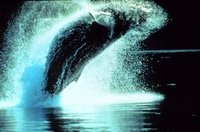Baleen Whales
|
|
| Baleen whales | ||||||||||
|---|---|---|---|---|---|---|---|---|---|---|
 Humpback Whale breeching | ||||||||||
| Scientific classification | ||||||||||
| ||||||||||
| Families | ||||||||||
Scientifically known as the Mysticeti, the baleen whales, also called whalebone whales or great whales, form a suborder of the order cetacea. The distinguishing feature between this suborder and the toothed whales is that baleen whales have baleen plates instead of teeth in the upper jaw, which enables them to filter food from water. Teeth are present only during the embryonal phase, except for fossil baleen whales which yet had teeth instead of baleen.
Baleen whales are generally larger than toothed whales, and the females are larger of the two sexes. This group comprises the largest living animal species. Baleen whales have two blowholes, causing a V-shaped blow.
The suborder contains four families and fourteen species. A list of species can be found below and at the cetacea article. Its scientific name derives from the Greek word mystax, which means "moustache."
| Contents |
Feeding
Baleen whales do not have teeth. Instead, they have baleen, using which they engulf sea water containing crustaceans, then close their mouths and create internal pressure by raising their tongues toward the palates to push the water out, trapping small ocean animals, especially krills and planktons, inside.
This is called filter feeding, and is also used by Flamingos. Even though individually the crustaceans are minuscule, the baleen whales take in an enormous volume of water containing them daily to maintain their survival.
There are several types of food-finding methods:
- Gulpers (swallowers): swim and open mouths alternatively. e.g., Blue Whales, Pygmy Blue Whales, Fin Whales, Bryde's Whales, Humpback Whales, and Minke Whales.
- Skimmers: predominantly have their mouths open during swimming. e.g., right whales, Pygmy Right Whales, and Bowhead Whales
- Benthic feeders: Gray Whales
- Combined: Sei Whales are both swallowers and skimmers
Behaviour
Movement
Baleen whales live in all oceans. All species travel seasonally. They spend the summer in cold waters in high latitudes, where they feed. In autumn they move to warmer waters to mate and give birth. Except in their feeding grounds, baleen whales eat little or fast for months. The Gray Whale even travels the longest migratory route of all mammals.
Breaching
In spite of their enormous mass, baleen whales are able to leap completely out of the water. Known for their acrobacy are the Humpback Whales, but other baleen whales also break through the water surface with their body or beat it loudly with their fins. The reason of these habits is not known for certain, and they may serve several purposes.
Sound
In contrast to toothed whales, baleen whales are unlikely to echo-locate. Instead they are able to produce sounds in the infrasonic range of high volume. The calls of the largest whales can be heard several 100 kilometers away. Unique are the songs of the Humpback Whales, consisting of complex sequences that may slowly evolve over years. They are probably used for courting. See the whale song article for a fuller description.
Miscellaneous
In the 19th and early 20th centuries, baleen whales were hunted for their oil and baleen. Their oil can be made into margarine and cooking oils. The function of baleen can be found in the baleen article.
Taxonomic classification
- ORDER CETACEA
- Suborder Mysticeti: Baleen whales
- Family Balaenidae: Right whales and Bowhead Whale
- Genus Balaena
- Bowhead Whale, Balaena mysticetus
- Genus Eubalaena
- Atlantic Northern Right Whale, Eubalaena glacialis
- Pacific Northern Right Whale, Eubalaena japonica
- Southern Right Whale, Eubalaena australia
- Genus Balaena
- Family Balaenopteridae: Rorquals
- Subfamily Balaenopterinae
- Genus Balaenoptera
- Fin Whale, Balaenoptera physalus
- Sei Whale, Balaenoptera borealis
- Bryde's Whale, Balaenoptera brydei
- Pygmy Bryde's Whale, (Eden's Whale) Balaenoptera edeni
- Blue Whale, Balaenoptera musculus
- Northern Minke Whale, Balaenoptera acutorostrata
- Southern Minke Whale, (Antarctic Minke Whale) Balaenoptera bonaerensis
- Balaenoptera omurai, discovery announced November 2003. No common name yet in usage
- Genus Balaenoptera
- Subfamily Megapterinae
- Genus Megaptera
- Humpback Whale, Megaptera novaeangliae
- Genus Megaptera
- Subfamily Balaenopterinae
- † Genus Eobalaenoptera
- † Eobalaenoptera harrisoni, fossil species first discovered June 2004. No common name.
- Family Eschrichtiidae
- Genus Eschrichtius
- Gray Whale, Eschrichtius robustus
- Genus Eschrichtius
- Family Neobalaenidae: Pygmy Right Whale
- Genus Caperea
- Pygmy Right Whale, Caperea marginata
- Genus Caperea
- Family Balaenidae: Right whales and Bowhead Whale
- Suborder Mysticeti: Baleen whales
Pictures of Animals
- Classroom Clipart Pictures and Photos of Animals (http://classroomclipart.com/cgi-bin/kids/imageFolio.cgi?direct=Animals)
Animal Clipart
- Animal Clipart (http://classroomclipart.com/cgi-bin/kids/imageFolio.cgi?direct=Clipart/Animals)
